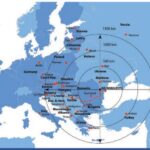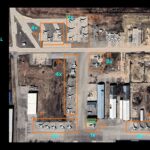After nearly six months of staying in open waters, the “Abraham Lincoln” Carrier Strike Group (CSG) completed a scheduled transit through the Strait of Hormuz (SH) into the Persian Gulf on November 19. Carrier Air Wing Seven (encompassing over 30 F/A-18E/F SuperHornets), the guided-missile cruiser Leyte Gulf, and guided-missile destroyers Bainbridge, Mason, and Nitze are assigned to the strike group.
This was the first SH transit for the Nimitz-class USS “Abraham Lincoln” (CVN-72) ever since it was hurried to the Middle East in May 5, 2019, in response to undisclosed intelligence warning of an imminent Iranian attack. However, after decades of American aircraft carriers sailing through the SH, the U.S. Navy made the decision to keep the CVN-72 in open waters for security reasons. Satellite imagery showed the CVN-72 loitering in a “tight operational box” in the North Arabian Sea, the Gulf of Oman and occasionally conducting port calls at Duqm, Oman for the past five months.
USS Abraham Lincoln (CVN-72) in the Arabian Sea https://t.co/XSCrUrKwnq pic.twitter.com/r1kyTVL88f
— Samir (@obretix) October 21, 2019
The Iranian militaries regularly rehearse asymmetric tactics to trap and sink U.S. aircraft carriers in the Persian Gulf in case of conflict. Aircraft carriers are particularly vulnerable when passing through the SH, which is 30 km at its narrowest. The recent decision to forward deploy CVN-72 into the enclosed Gulf could indicate that the threat posed by Iran decreased to an acceptable level for transiting the strait.
THE IRANIAN THREAT
The intelligence alerting to an imminent Iranian threat proved valid as the Iranian Revolutionary Guards Corps (IRGC) staged numerous – convert and overt – attacks and provocations against commercial vessels and Western navies transiting the local waterways and even raided petrochemical facilities onshore:
- On June 13, 2019, The Panama-flagged “KOKUKA COURAGEOUS” (KG) and the Marshall Islands-flagged “FRONT ALTAIR” (FA) were attacked with seaborne ordnance (limpet mines or anti-ship missiles) by an unconfirmed aggressor in the Strait of Hormuz (SH). The US Navy has since released a video, filmed by a P-8 maritime security aircraft, which allegedly shows an Iranian naval unit removing an unexploded limpet charge from the KG’s hull, likely in an attempt to destroy evidence.
New images from the US Military showing the Iranian fast attack craft next to the Kokuka Courageous removing an object (Limpet Mine) and the damage caused to the ship #Iran pic.twitter.com/jKeD7PvO1A
— CNW (@ConflictsW) June 17, 2019
- The covert attack on KG and FA took place nearly a month after four commercial vessels (two Saudi Arabian tankers, one Norwegian tanker, and an Emirati bunkering ship) were damaged using limpet mines in the Emirati port of Fujairah (Gulf of Oman). Both operations are believed to have been conducted by the IRGC-Navy’s special operations forces known as the “Sepah” specialized in underwater demolition, sabotage, search & destroy and unconventional operations – a loose equivalent of the U.S. Navy’s DEVGRU (or “SEALs”).
- On June 20, 2019, the IRGC-Aerospace Forces (IRGC-AF) downed a U.S. Global Hawk BAMS-D unmanned aerial vehicle (UAV) near the SH using a “3rd Khordad” surface-to-air missile (SAM) system. Tehran accused the U.S. of violating its airspace while Washington claimed that it remained in international airspace. The Department of Defense drafted plans for retaliation against Iran’s coastal aerial defense systems and radars but the operation was later aborted by President Trump. The attack was a major milestone for Tehran. The IRGC proved that it can attack the U.S. and get away with it while also validating its indigenous defense technologies.
#IRGC Aerospace Force has put on display the 3rd Khordad surface-to-air missile system which hunted the #USNavy RQ-4A #GlobalHawk spy drone over #Oman Sea earlier this year. Note: Kill mark of the RQ-4A (MQ-4C prototype) is painted on its door. pic.twitter.com/Ynvp4jRygJ
— Babak Taghvaee (@BabakTaghvaee) September 21, 2019
- On July 18, 2019, the USS Boxer downed an IRGC-AF UAV that closed within a threatening range, as the amphibious ship was transiting through the SH. The Marines on board the Boxer neutralized the threat through a “soft kill” approach (i.e. electronic attack) using the Light Marine Air Defense Integrated System (LMADIS). The day before, a U.S. Seahawk helicopter chased away an Iranian Navy Bell 212 helicopter that approached the Boxer shortly after it entered the SH.
- On July 20, 2019 the IRGC-Navy seized the British-flagged STENA IMPERO (SI) through an air-naval assault on the commercial ship near the SH. Tehran justified the operation as “tit-for-tat” after the British Royal Marines seized an Iranian-owned Panemese-flagged very large crude carrier (VLCC) vessel (“GRACE-1”) in Gibraltar found to be in breach of European Union (E.U.) oil embargo against the Syrian regime. Gibraltar authorities released the vessel (renamed as “ADRIAN DARYA-1”) in good faith on August 15, after receiving assurances from Tehran that it will not sell oil to Syria. However, DARYA-1 sailed to the Syrian coastline, where satellite imagery showed it unload oil via ship-to-ship (STS) transfer. Iran was late to reciprocate and only released the SI on September 27, 2019.
Anyone who said the Adrian Darya-1 wasn’t headed to #Syria is in denial. Tehran thinks it’s more important to fund the murderous Assad regime than provide for its own people. We can talk, but #Iran’s not getting any sanctions relief until it stops lying and spreading terror! pic.twitter.com/saar05T8wt
— John Bolton (@AmbJohnBolton) September 6, 2019
- On September 15, 2019, the Saudi Aramco petrochemical facilities in Abqaiq and Khurais were the subject of a low-observable and clandestine air attack involving nearly 20 expandable-UAVs and cruise missiles. In comparison to the countless other missile attacks mounted by the IRGC’s Yemenite partner force, “Ansar Allah” (Houthi) on Saudi/ Emirati oil facilities in the past, the September 15 raid was conducted directly by IRGC elements, and likely from Iranian territory.
TF-IMSC
The growing asymmetric maritime threat posed by Iran prompted Washington to establish a multinational operational task force that would police the Middle Eastern seas and ensure the freedom of navigation in the region. The Task Force (TF) is known as the “International Maritime Security Construct” (IMSC) and encompasses the United Kingdom, Australia, the Kingdom of Bahrain, the Kingdom of Saudi Arabia, the United Arab Emirates, besides the U.S. TF-IMSC is headquartered with the U.S. Fifth Fleet command center in Manila, Bahrain.
While the TF-IMSC is likely in the lengthy process of joint force integration, the CVN-72 is expected to project power and deter attacks on commercial shipping until its substitute, the USS Harry S. Truman” (CVN-75) enters the Fifth Fleet area of operations.
UPDATE: CVN-72 LEAVES THE PERSIAN GULF
Founder of T-Intelligence. OSINT analyst & instructor, with experience in defense intelligence (private sector), armed conflicts, and geopolitical flashpoints.






